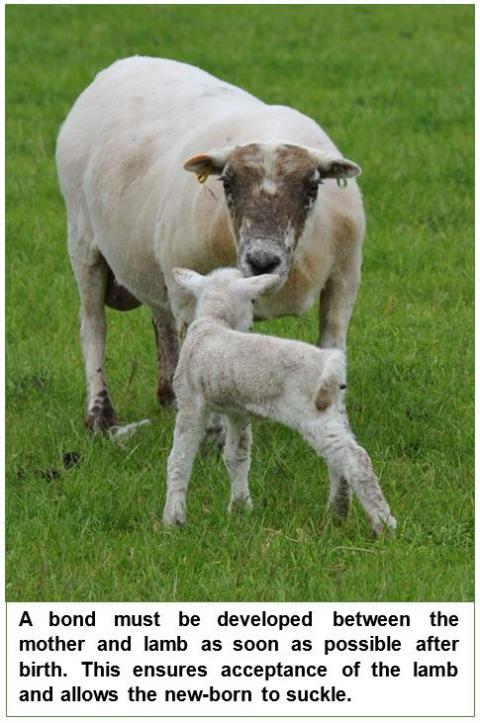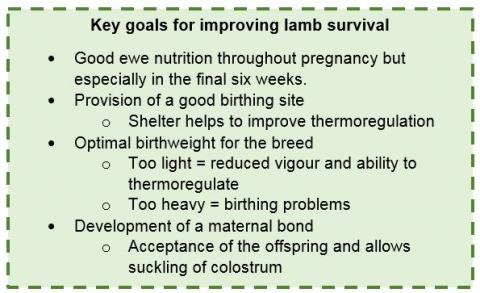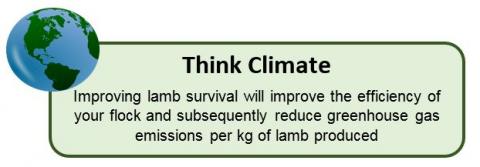Dr Ruth Wonfor: IBERS, Aberystwyth University
- A structured, farm specific management plan can successfully improve lamb survival.
- Lamb size is one of the largest risk factors for reduced lamb survival. Lambs born too small have a reduced ability to stay warm and suckle, yet those born too big have an increased likelihood of undergoing birthing trauma.
- The development of a bond between the ewe and lamb should be encouraged as early as possible after lambing to ensure acceptance of the lamb.
- A good provision of well-trained labour is imperative in the lambing period to ensure that any problems are picked up and dealt with as soon as possible.
- Future research will focus on the genetics of lamb survival to aid in the development of selection for this trait in breeding programmes.
A recent European scientific review has evaluated available research related to improving lamb survival. The review looks at how this research has been, and can be related back to ‘real farm’ practice to improve management of ewes and lambs and ultimately reduce lamb mortality rates.
Published average lamb mortality rates have changed very little over the past few decades, staying at around 15%, of which 50% will occur in the first 24 hours after birth. However, recent research suggests that it is possible for lamb mortality to not exceed 5% on-farm. In order to achieve this target, it must be realised that no two farms are exactly the same, and therefore management plans for the lambing period should be individual to farms. Yet the main principles stay the same and are rooted in the physiological, behavioural, nutritional and health requirements of the lamb and its mother both pre and post lambing.
Risk factors for lamb mortality can be grouped into four categories: trauma at birth; a poor bond between ewe and lamb; disease development and uncommon factors such as predation. The management system used will have a large effect on the types of risk factors that are more prevalent. Outdoor lambing is more likely to see a greater prevalence of deaths related to hypothermia and starvation, whereas indoor lambing is more likely to experience higher rates of infectious disease spread. This highlights that, although it is imperative to be aware of all risks for lambs in their first few days of life, you should concentrate on targeting your management plan to your system.
Physiological
A delayed birth due to difficulties such as dystocia can result in oxygen starvation and ultimately death if not managed properly. Staff employed for lambing should be well trained and able to deal with a range of lambing issues appropriately. More information on management of lambing is available from NADIS. Flocks which have better supervision, such as smaller indoor flocks, have a lower mortality rate. However, care should be taken to not over-supervise and hinder the development of the ewe to lamb maternal bond.
On leaving the womb, lambs undergo a drop in temperature. Smaller lambs find it harder to maintain their body temperature due to having a high surface area to body weight ratio. This means that small lambs lose heat much faster and so are more prone to hypothermia. The amount of brown fat a lamb is born with is imperative in these first few hours. Brown fat produces heat independent of the lamb shivering and so is essential to help the lamb to produce heat in its first few minutes of life to raise its body temperature.
As well as the immunological properties of colostrum, it is also essential that lambs ingest the high fat and energy content of colostrum to help increase heat production. However, smaller lambs are less efficient at suckling and so are often unable to suckle the required amount of colostrum. This becomes even more of a problem in outdoor lambs who, due to lower environmental temperatures, will require a larger volume of colostrum compared to indoor housed lambs. Twin lambs may further exacerbate the matter, not only are they often born smaller, but there is normally less colostrum per lamb compared to singles.
Behaviour
Ewe and lamb behaviour before and after lambing are important to understand to ensure that a strong maternal bond is made.
Before lambing takes place, ewes seek an appropriate area to lamb in, preferably a sheltered one to aid the new-born’s thermoregulatory ability. Therefore, when deciding where ewes will lamb, be it indoors or out, always make sure that there are plenty of areas, in relation to the flock size, that are sheltered and where ewes can remove themselves from the rest of the flock. If there are not enough lambing sites, ewes are more likely to lamb close together and there may be an issue over mismothering and contamination of sites. Provision of shelters in advance of lambing will ensure that ewes are used to them and likely increase their use.
Always ensure that ewes are not deficient in cobalt before mating and during early pregnancy. Cobalt is essential for vitamin B12 formation and vitamin B12 is necessary for early foetal development. Super-ovulated ewes on cobalt deficient pasture are shown to produce less active lambs, compared to supplemented ewes which receive the recommended levels of cobalt. Improving lamb vigour will help to develop the maternal bond.
To give the ewe and lamb plenty of time to develop a bond, the ewe should also want to stay in the lambing area. The ewe should develop a smell recognition of its offspring within the first hour after lambing. Maternal bonding and recognition begins through licking the birthing fluids and grooming the lamb. Failure to develop this bond will result in the lamb being unable to suckle from the mother as the ewe will not recognise the lamb as her own.
Improving lamb vigour through genetic selection has been demonstrated to be moderately heritable, and so could be selected on to improve lamb survival. By improving vigour, lambs will find it easier to stand earlier, which will help to reduce heat loss, but is also the first step to beginning to co-ordinate itself to get to the udder. The sooner the lamb reaches the udder and suckles, the more likely they are to survive. If possible, the lamb should have its first suckle in the first 2 hours after lambing.
Health
Lambs require a passive immunity from their mother through intake of colostrum in the first 24 hours after birth. Those that do not consume enough colostrum have a low concentration of antibodies which the colostrum provides, which is subsequently associated with lamb
mortality. Therefore, production of good quality colostrum is important, as is the ability of the lamb to suckle. Yet there are variations in colostrum quality, even within a flock. As many as 22% of ewes on-farm are reported to produce colostrum that is inadequate for the lamb (<50 g/L immunoglobulin G). There are several ewe related factors which affect colostrum quality, but the main factor in control of the farmer is nutrition provision in late pregnancy.
Recent on-farm research has shown that it is better for lambs to suckle colostrum for themselves. Flocks that are tube fed have higher mortality rates, which may be attributed to infections transmitted through the tube. If you need to tube feed, ensure that you have plenty of tubes ready and that they are properly disinfected before use.
Hygiene must be maintained throughout the lambing period to prevent the spread of infection, especially in indoor systems. It appears that the main focus during this period should be management practices, rather than housing itself, to reduce pathogen loads. New bedding should be provided daily in lambing pens during the initial neonatal period. Biosecurity measures are essential during the lambing period to reduce the introduction of pathogens to new-borns and their mothers.
Nutrition
Under nutrition of outdoor ewes is common during pregnancy due to the lack of nutrient rich grazing during winter. Ewes that are underweight before mating are less likely to be able to cope with undernutrition during pregnancy, as they have less fat reserves to draw on. Therefore regular body condition scoring around mating is important. KPI work at AHDB Beef and Lamb advises aiming for a body condition score at tupping of 2.5 for hill ewes; 3 for upland and 3.5 for lowland, this will also increase lamb weaning weights. Yet a recent review of scientific literature concluded that if ewes undergo undernutrition in the final third of pregnancy, they will consistently produce lambs with a reduced birthweight. However, if undernourished in the first two thirds of pregnancy, no consistent effect is seen on lamb birthweight. Breeds that are better adapted for living outside in severe weather are able to cope with undernutrition in the beginning of pregnancy compared to breeds that are selected for growth. This type of information should inform management on farms deciding whether to use indoor or outdoor lambing.
A further consideration is the effect of nutrition on the quality of colostrum produced. Metabolic profiling three weeks before lambing can be useful to investigate the nutritional state of your ewes. At three weeks, there is still enough time to tweak the nutrition to improve colostrum.
A temptation may be to overfeed to ensure that ewes receive the nutrition that they need and try to maximise lamb birthweight. However, this is not the case as there are also problems encountered with over nutrition. There also appears to be an optimal birthweight range and lambs born either side of this range are at a higher risk of mortality. This is breed specific, for example, a project in Scotland showed that for the Scottish blackface, the optimal birthweight is between 3 and 5 kg. Those born at higher birthweights are more likely to encounter birthing issues such as dystocia.
What about genetics?
Selecting for lamb survival helps to improve animal welfare on-farm, however, it is well documented that the trait of lamb survival alone has a low heritability. Yet there are some traits which may not only help to increase lamb survival but also the need for human intervention during the lambing period. This will increase production, whilst also reducing labour costs. Such traits include lamb vigour and lambing ease. Research is being carried out to investigate the genetics of lamb survival, with the view of developing genomic breeding values, although these will need to be breed specific. Such research will be able to increase genetic gain in the sheep sector to help reduce lamb mortality.
Whilst developing a flock health plan with your vet, consider the issues discussed in this article. Always consult your vet for advice or information on any lamb health and disease issues.
For more information, see the HCC booklet ‘Making every lamb count’.




